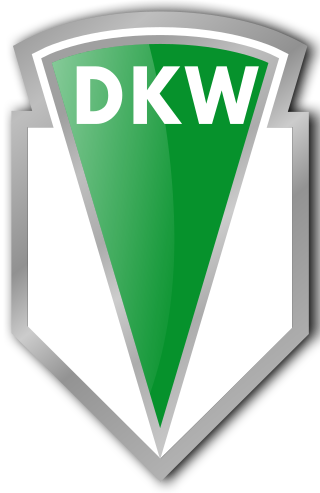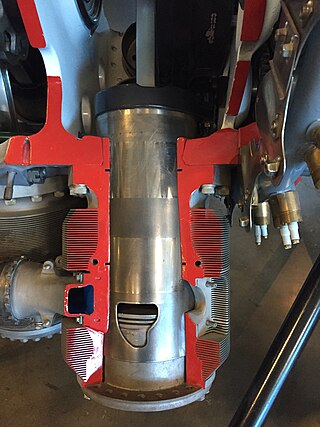
DKW was a German car- and motorcycle-marque. DKW was one of the four companies that formed Auto Union in 1932 and thus became an ancestor of the modern-day Audi company.

A V12 engine is a twelve-cylinder piston engine where two banks of six cylinders are arranged in a V configuration around a common crankshaft. V12 engines are more common than V10 engines. However, they are less common than V8 engines.

A V6 engine is a six-cylinder piston engine where the cylinders share a common crankshaft and are arranged in a V configuration.

The sleeve valve is a type of valve mechanism for piston engines, distinct from the usual poppet valve. Sleeve valve engines saw use in a number of pre–World War II luxury cars and in the United States in the Willys-Knight car and light truck. They subsequently fell from use due to advances in poppet-valve technology, including sodium cooling, and the Knight system double sleeve engine's tendency to burn a lot of lubricating oil or to seize due to lack of it. The Scottish Argyll company used its own, much simpler and more efficient, single sleeve system (Burt-McCollum) in its cars, a system which, after extensive development, saw substantial use in British aircraft engines of the 1940s, such as the Napier Sabre, Bristol Hercules, Centaurus, and the promising but never mass-produced Rolls-Royce Crecy, only to be supplanted by the jet engines.

The straight-eight engine or inline-eight engine is an eight-cylinder internal combustion engine with all eight cylinders mounted in a straight line along the crankcase. The type has been produced in side-valve, IOE, overhead-valve, sleeve-valve, and overhead-cam configurations.

In an internal combustion engine, the cylinder head sits above the cylinders and forms the roof of the combustion chamber. In sidevalve engines, the head is a simple sheet of metal; whereas in more modern overhead valve and overhead camshaft engines, the cylinder head is a more complicated block often containing inlet and exhaust passages, coolant passages, valves, camshafts, spark plugs and fuel injectors. Most straight engines have a single cylinder head shared by all of the cylinders and most V engines have two cylinder heads.

L'Aster, Aster, Ateliers de Construction Mecanique l'Aster, was a French manufacturer of automobiles and the leading supplier of engines to other manufacturers from the late 1890s until circa 1910/12. Although primarily known as an engine mass manufacturer the company also produced chassis for coach-works and a complete range of components.

The Turicum was a Swiss automobile manufactured from 1904 to 1906 in Zürich, and from 1907 to 1912 in Uster. Turicum is the Latin name of Zürich. The first car made by Martin Fischer was a small single-seater go-kart like vehicle, 140 cm long, with pedal-operated steering and powered by a motorcycle engine. It had chain drive, while a second prototype had friction drive. The friction drive consisted of a flat steel disc coupled to the engine that drove a small, leather-covered wheel running at right angles to its surface. The small wheel could be moved across the surface of the large disc, giving a variable gear ratio. They attracted little public interest. Swiss industrialist Jakob Heusser was also involved in the venture.

In an internal combustion engine, the engine block is the structure which contains the cylinders and other components. In an early automotive engine, the engine block consisted of just the cylinder block, to which a separate crankcase was attached. Modern engine blocks typically have the crankcase integrated with the cylinder block as a single component. Engine blocks often also include elements such as coolant passages and oil galleries.
The Lanchester Motor Company Limited was a British car manufacturer in active trade between 1899 and 1955. Though the Lanchester Motor Company Limited is still registered as an active company and accounts are filed each year, the marque has been dormant since. As of 2014 it is marked as "non-trading".

Wolseley Motors Limited was a British motor vehicle manufacturer founded in early 1901 by the Vickers Armaments in conjunction with Herbert Austin. It initially made a full range, topped by large luxury cars, and dominated the market in the Edwardian era. The Vickers brothers died and, without their guidance, Wolseley expanded rapidly after the war, manufacturing 12,000 cars in 1921, and remained the biggest motor manufacturer in Britain.

Established in 1901, Belsize Motors was based in Clayton, Manchester, England. The company was founded by Marshall & Company and took its name from their Belsize works, where they had built bicycles.
Lloyd Cars Ltd was a British motor manufacturer, founded by Roland Lloyd (1904–1965), son of a garage owner, and based in Patrick Street, Grimsby, Lincolnshire, England between 1936 and 1951. Two models were made, separated by World War II; the company was unusual for a small manufacturer in making nearly all components in-house. After car production ceased the company continued in general engineering until 1983. During World War II the company made components for Rolls-Royce Merlin aircraft engines.

A crankpin or crank pin, also known as a rod bearing journal, is a mechanical device in an engine which connects the crankshaft to the connecting rod for each cylinder. It has a cylindrical surface, to allow the crankpin to rotate relative to the "big end" of the connecting rod.
The Thrige was a Danish automobile manufactured in Odense between 1911 and 1917 by the Thomas B. Thrige company. The company was founded in 1894 and made electric motors.

A V8 engine is an eight-cylinder piston engine in which two banks of four cylinders share a common crankshaft and are arranged in a V configuration.
Automobiles Grégoire was a French manufacturer of cars and aero engines, established in 1902 in operation for about 20 years. The company grew from an earlier enterprise making engines under the name "Cyclone", established in 1899 by Louis Soncin, in Poissy, but was largely the creation of Pierre Joseph Grégoire.
The Success Automobile Manufacturing Company was a brass era United States automobile manufacturer, located at 532 De Ballviere Avenue, St. Louis, Missouri, in 1906.

C.I.M.E., CIME, La Compagnie Industrielle des Moteurs a Explosion,, was a French manufacturer of light proprietary engines, mainly four-cylinder units. CIME also built light automobiles in 1929.

The Talbot Baby is a six-cylinder executive sporting car launched by the French Talbot company in 1936. Three standard body types offered were a "coach", a two-door four-seater "cabriolet" and a two-door two-seater "cabriolet". The Baby was one of the first new models to appear after the French part of the Anglo-French Sunbeam-Talbot-Darracq combine was purchased, in 1935, by auto-entrepreneur Tony Lago. Production slowed with the onset of war and had ended completely by mid-1942 when the manufacturer's Suresnes plant was converted for war production.














